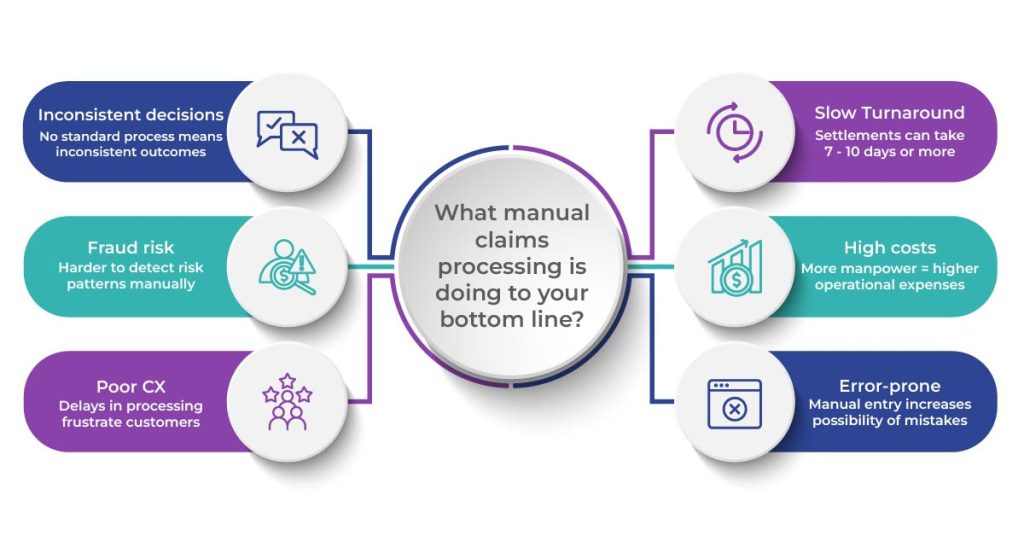According to a McKinsey report, more than 50% of insurance claims activities could be replaced by automation. It is no shock that your insurance customers expect real-time support, digital-first experiences, and faster claim settlements when claims processing automation can slash settlement times by up to 70% and ensure faster payouts. So, what actually goes on behind the scenes after a loss is reported and where insurance claims automation fits in? This blog will walk you through each step of the claims journey and show how automation is changing the game from start to end.

Claims processing: How automation fits into every stage & what your gains would be
Data capture and verification
Manually linking policy data files is tedious and has scope for human error. Robotic Process Automation (RPA) effortlessly gathers necessary information from emails, forms, and uploaded documents, while intelligent automation leverages machine learning to interpret unstructured data and extract contextual information from complex documents. This combination instantly verifies claims against policy rules, identifies anomalies, and adapts to new document formats without manual reconfiguration. Automated claims processing eliminates missing details, human errors, and the time-intensive manual verification process—allowing your teams to focus on complex decision-making rather than data validation tasks.
Blurb
By 2030, more than 50% of current claims activities could be replaced by automation – Source: McKinsey
Claims fraud: Automated claims processing and anomaly detection
Fraudulent claims cost the insurance industry billions annually, but intelligent automation provides sophisticated detection capabilities that protect both insurers and legitimate claimants. Advanced anomaly detection systems analyze claim patterns, historical data, and risk indicators to identify potential fraud without creating friction for valid claims.
Risk-based scoring: Every claim receives a risk assessment score based on data patterns, claim complexity, and statistical anomalies. Low-risk claims proceed through automated processing, while high-risk cases – based on risk thresholds you set – are escalated to specialized fraud investigators with comprehensive supporting analysis. This targeted approach optimizes investigative resources while maintaining processing efficiency for legitimate claims.
5 key aspects of anomaly detection
- Pattern spotting – Identifies deviations from established claim patterns and industry benchmarks
- Machine learning algorithms – Continuously refines detection accuracy using historical fraud data and emerging threat patterns
- Multi-dimensional analysis – Examines claim relationships, timing, and cross-referencing across multiple data sources
- Real-time alerts – Flags potential issues immediately upon claim submission for rapid response
- Intelligent risk stratification – Prioritizes investigation resources based on fraud probability and potential financial impact
This approach protects your organization’s financial integrity while ensuring legitimate claimants receive prompt, fair treatment throughout the claims process.
- Continuous improvement
One of the best parts? The system gets better over time. The system employs machine learning to refine detection algorithms with each processed claim, reducing false positives and improving decision accuracy over time. This continuous optimization ensures legitimate claims move through processing efficiently while maintaining robust fraud detection capabilities.
- Beyond fraud – Complete claims optimization
Anomaly detection isn’t just about stopping the bad apples. It extends beyond fraud prevention to enhance overall claims operations. By automating risk assessment and streamlining decision workflows, the system accelerates processing times, improves transparency for all stakeholders, and creates a more efficient claims experience that benefits both insurers and policyholders through faster resolutions and reduced administrative complexity.
Conclusion
Automated insurance processing delivers measurable ROI through reduced operational costs, accelerated claim cycles, and enhanced accuracy metrics. This strategic implementation of RPA and intelligent automation transforms claims operations from cost centers into competitive differentiators that drive customer retention and operational excellence.
When selecting a partner for claims automation, it’s essential to focus on ones with proven insurance domain expertise, robust AI/ML capabilities, and scalable cloud-native architectures.
- Insurance Automation Sweet Spot: When To Automate And When To Keep The Human Touch - August 26, 2025
- One Bug. One Bad Release. One Costly Mistake: Why New-Age Insurance Application Testing Matters - August 19, 2025
- The Grey Wave Is Here: Is Your Insurance Technology Solutions Inclusive Enough? - July 25, 2025

 Write to Us
Write to Us